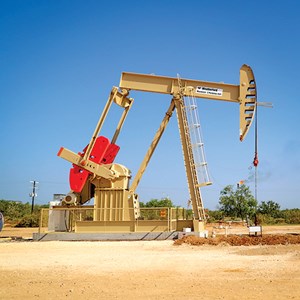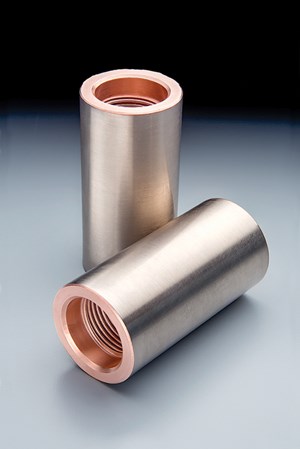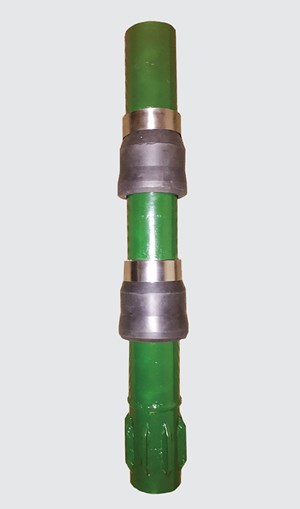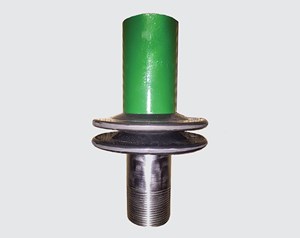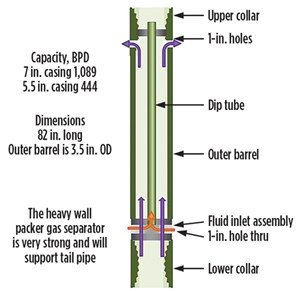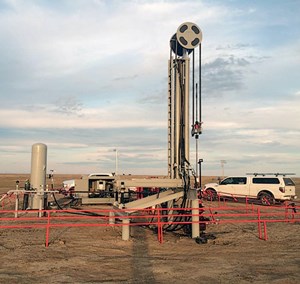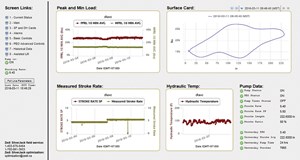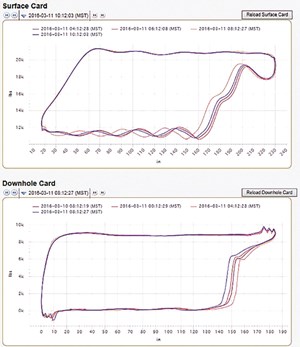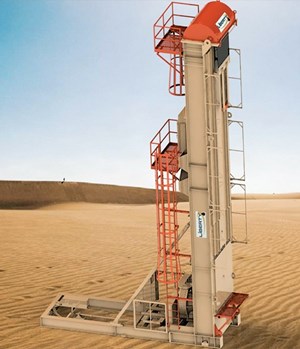What’s new in artificial lift?
For the last several years in this feature, we have classified artificial lift systems into three categories for reference purposes: 1) pump-assisted systems; 2) fluid-assisted systems; and 3) flow enhancement techniques. Within these three categories (Table 1), there are basically 11 types of lift technologies. In each category, there also exist unconventional or emerging technology types of lift.
Typically, in May’s issue, we cover beam/rod pumping, linear lift units, hydraulic piston pumps and hydraulic jet pumps. In the June issue, we cover ESP, PCP, gas lift, plunger lift, power-related technologies and other artificial lift developments.
This year, in our search for new hydraulic piston pump and hydraulic jet pump developments, we found no significant technology advancements. Perhaps we overlooked something. If so, please let us know, so that we can include it in this feature next year.
BEAM/ROD LIFT DEVELOPMENTS
The basic beam rod pump system consists of three major components: a surface beam pump, a connecting rod string, and a downhole plunger pump. The system is, obviously, connected to a power source. Here are five recent offerings that we think you’ll find of interest.
New and improved Class-I, crank-balanced pumping unit. Weatherford’s new Maximizer III pumping unit is a Class-I, crank-balanced unit with a conventional, rear-mounted geometry, Fig 1. This design allows the unit to operate in clockwise and counter-clockwise crank-rotation direction, which equalizes gear wear and extends the life of the gear reducer. The unit is available in sizes 114 through 1824, and combines Weatherford’s conventional structure with the company’s robust Maximizer gear-reducer technology.
The gear reducer features an oiling system that lubricates at speeds as low as one stroke per minute (spm), without the need for a secondary lubricating system. Within the gear reducer, the tangential and separating forces generated by operating torque are distributed equally between the bearings at both ends by using a symmetrical, double-reduction and double-helical gear train. The bearings are designed for durability and, when properly maintained, have a life expectancy that far exceeds API 11E specifications.
The bending moments at the shaft are also distributed equally between bearing supports, which reduces bending stresses and results in a smooth, quiet operation. The low speed shaft uses a design that minimizes stress risers and failure points, which results in a factor of safety against fatigue failure greater than 2:1.
This gear reducer design requires less torque input than other gear reducers, to produce the same torque output. By providing greater efficiency and, consequently, lowering power consumption, the Maximizer III unit meets operators’ demands for energy-efficient pumping units.
The Maximizer III uses common components from other Weatherford pumping unit product lines, which enables operators to minimize spare parts inventories and increases efficiency in maintenance and repair operations. Bearing assemblies can be replaced easily without any special tools, reducing total operating cost.
Power automation improves rod pump operating efficiencies. Due to the industry downturn and need to reduce spending practices, many operators are “sticking to the grid” and drilling new wells within parameters close to permanent utilities. However, where permanent utilities are not an option, such as in remote production areas of the U.S., temporary power providers are becoming increasingly challenged to develop innovative technologies, off the grid, that meet environmental regulations and satisfy stringent economic requirements.
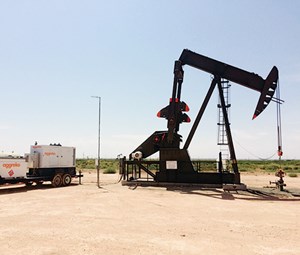
The beam/rod pump is a common, intermittent oilfield machine that has, historically, utilized diesel generators for continuous power…24 hours a day, 7 days a week. When evaluating the operation and power requirements of a beam/rod pump, the equipment usually requires power for just a few hours each day. The remaining time, pump operation pauses while waiting on the reservoir to fill up again, all the while, diesel generators continue idling, burning fuel and often producing unnecessary pollutants.
By deploying an automated power system, such as those provided by Aggreko (Fig. 2), operators can eliminate idle hours and reduce the associated high costs of burning fuel continuously. Customized automated power kits can be retrofitted on both diesel and natural gas generator sets to communicate with an operator’s programmable logic controls on rod pumps. The design of the controls allows the generator to automatically start, when the pump needs power, and stop when it doesn’t. This simple practice not only saves fuel and reduces emissions, but it also increases uptime, due to lower maintenance needs and fewer failures associated with overheating or excessive idle time.
Recently, one of the largest E&P companies operating in the Permian basin had five vertical wells with associated, 40-hp rod pumps that ran intermittently. The operator strived to obtain a more cost-effective, environmentally-friendly solution by which the pumps would run, only when needed.
This operator consulted with Aggreko to develop a scalable, easily deployable power automation solution. For each of the five wells, Aggreko provided a 16-ft trailer that held an 800-gal fuel tank and 60-kW diesel generator, featuring an automated power control system. The power system was linked to the pump’s programmable logic controls, thus enabling the ability to turn off the generator, when the pump was not in operation, and back on when needed.
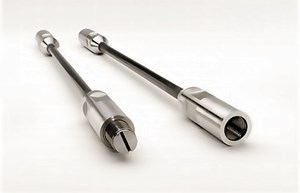
This power automation solution cut the operator’s fuel costs in half, resulting in a 40% reduction in cost over the course of six months. Emissions also were reduced more than 50%.
Carbon-fiber sucker rods. Megalex, LLC, has developed new high-strength, lightweight, small-diameter, corrosion-resistant, carbon-fiber sucker rods. Megalex 5/8-in. rods (Fig. 3) have the fatigue strength of 1-in., ultra-high-strength, steel sucker rods, but at only 12% of the weight. The 15/8-in. end-fitting diameter allows for operation in 23/8-in. tubing. Megalex rods are enabling technology for dewatering deep gas wells with sucker rod pumping, because deep gas wells typically use 23/8-in. tubing, and 1-in. rods cannot fit in 23/8-in. tubing.
These lightweight rods can lower peak polished rod loads, allowing longer-stroke beam units to be used without over-torqueing the pumping unit gear reducer. Longer-stroke beam pumping allows more time for pump fillage, a better pump compression ratio for gassy wells, and fewer rod pumping cycles than a shorter-stroke unit producing the equivalent output.
Megalex’s patent-pending, end-fitting design does not limit the use of the full, 235,000-psi tensile strength of the carbon-fiber rod body. Additionally, these rods have threaded box ends, which join together with pin-to-pin threaded couplings. This unique design allows for one friction face for every connection instead of two, as is the case with standard box-to-box couplings. Loss of circumferal displacement is a perennial problem with sucker rod connections. The Megalex design reduces the number of connections 57% when compared to an equivalent length of steel rods, thus reducing the opportunity for loss of displacement failures. The company uses API threads, so that steel rods can be connected to the Megalex rods.
Like fiberglass rods, carbon-fiber rods need to be run in tension, so heavier steel rods or sinker bars must be in the lower section of the rod string below Megalex rods. These new sucker rods are distributed by Lone Star Artificial Lift Systems, LLC.
New sucker rod couplings. Materion’s patent-pending ToughMet 3 sucker rod couplings (Fig. 4) are designed to maximize production output and significantly reduce the costs of artificial lift operations, when used in place of sucker rod couplings made of conventional materials. According to the manufacturer, these new couplings reduce the frequency of sucker rod coupling and production tubing damage, which are leading causes of well failure.
Made from a unique temper of copper-nickel-tin spinodal alloy engineered by Materion specifically for use in the oil field, the couplings resist mechanical wear, thread damage, corrosion and erosion. They are non-galling to prevent damage to production tubing, and they retain their strength, even at elevated temperatures. This combination of attributes minimizes the frequency of workovers associated with couplings made of other materials.
Isolated tailpipe improves rod pump performance in horizontal wells. Flow regimes and fluid dynamics in horizontal wells are different and more challenging than production in vertical wells. Considering the various dips, undulations, gas-liquid ratios, and pressures, the resultant slugging behaviors of produced gases and fluids are quite difficult for conventional, rod pump bottomhole designs to handle. This is due partially to operators using less-than-optimal separators, and also due to the long-required flow path that must be taken to reach a pump set at the kick-off point. Echometer offers a patented solution that is both economic and functional.
First, to resolve the flow regime problem, the cross-sectional flow area of the open casing, in the curved section of the wellbore, must be reduced. This is achieved by running a properly sized tailpipe section below the rod pump, to be landed at the top of the curve immediately above the kickoff. The optimal landing point for end of tubing is 65° to 75°, but a second check for optimal placement would put the end of the tailpipe 20 ft, TVD, above the landing point of the curve. The tailpipe diameter and length will vary by well, based on anticipated fluid volumes and the shape of the curve, Table 2.
Tailpipe, alone, does not solve the problem, but pairing it with a method of isolation and a diversion style separator does. Echometer has designed an application-specific Isolator Tool (Fig. 5) that can seal the casing-tubing annulus and direct all flow inside the tailpipe. This allows for manipulation of the gas void fraction (GVF) of the produced fluid stream. Where typically there would be ~50% GVF, in and through the curve of open 5.5-in. casing, with an isolated tailpipe there will be ~80% GVF. Therefore, the gradient of the column of fluids is reduced substantially, even with the pump in the same position at the top of the curve. Pumping bottomhole pressure can be ~200 psi less than before, and with the improved performance in the tailpipe. Additionally, fluid flow is smoother and more consistent, and pump cards are fuller more often.
It is recommended that this setup be run with a diversion-style separator. Echometer now offers a newly revised, improved diversion-style separator, Fig. 7. The separator is set best at the kickoff point, with Echometer’s Tool Saver (Fig. 6) immediately below the separator and a Hi-flow tubing anchor catcher (TAC) below that. The Tool Saver will keep sand/debris off the TAC and control the volume of sand that can fall, at once, on top of the anchor as it is pulled out of the hole. The Isolator Tool is run below the TAC. Its placement will vary slightly, based on the well’s casing design.
This tailpipe system has, consistently, yielded a sustained 10%-to-30% gain in production, in 80+ test wells run to date; much more in some cases. Implementing the system, when a well is being pulled for other work, adds little incremental cost. It will ensure that production is maximized for the long-haul, as well as increase reliable and consistent pump operation, leading to fewer failures and less downtime.
LINEAR LIFT PUMP DEVELOPMENTS
For various operational efficiencies over the last several years, operators have employed multi-well drill pads that reduce operational footprints at wellsites. This has placed even more focus on pump solutions that offer the required horsepower performance, while minimizing the physical size and footprint of onsite production equipment. Often the most efficient and cost-effective forms of artificial lift, beam/rod pumps or reciprocating rod lift systems have drawbacks, sometimes in tight, multi-pad developments and in populated areas.
Linear lift pumping units can provide a cost-efficient, compact, lighter-weight alternative to traditional beam pumping units in many multi-pad, horizontal well applications.
Nitrogen-assisted hydraulic lift system, with advanced optimization capabilities. Zedi recently introduced an addition to its next-generation, linear lift rod pumping technology. The Zedi SilverJack 8000 artificial lift system (Fig. 8) is designed to help producers increase efficiencies, lower costs and utilize Zedi’s optimization capabilities on higher-production wells.
This new unit includes all features available in the SilverJack 6000 (such as full remote control, precise rod string control, and advanced optimization capabilities) (see World Oil, May 2015), but it is designed for deeper and larger producing wells with its nitrogen gas-assisted lift technology. At up to 45,000 lbs rod string weight, and 240-in. stroke length, the SilverJack 8000 supports twice the capacity of the SilverJack 6000. With its double activating cylinder system, automated N2 storage, closed-loop hydraulic power pack, and sophisticated controller; the SilverJack 8000 offers built-in optimization capabilities that replace expensive and labor-intensive manual processes.
The company’s integrated Access web-based data management system allows all optimization operations to be performed remotely. Released with the new linear lift unit is the new “current status” screen on the data management system, which provides the user a live dashboard of the well’s key parameters necessary to optimize production, Fig. 9. Also new is a multiple time-stamped surface and downhole pump cards display (Fig. 10), allowing a user to view pump card trends on one screen.
The new hydraulic lift system was designed for the life cycles of modern horizontal wells. Inconsistent flow, gas interference, frac sand and other debris, and a steep decline in production during a well’s transient phase is mitigated by the flexibility to make quick changes and visibility of key well parameters provided by the system. The aim of this intelligent artificial lift system is to maintain peak efficiency while increasing production, and decreasing downtime throughout a well’s entire life cycle.
A long-stroke unit in an environmentally-friendly, compact package. With no exposed moving parts, Weatherford’s new EnviroLift hydraulic long-stroke pumping unit provides safe operational levels unmatched by conventional beam pumping units. All moving parts are fully encapsulated within the EnviroLift cylinder, which makes rod pumping inherently safer for field personnel, and for the public. The 240-in. stroke unit is supported vertically on the integrated wellhead and contained in a single, 5-in. diameter cylinder, which significantly reduces the surface footprint. The cylinder is fastened securely to the wellhead and withstands winds up to 100 mph, with no guy wires needed. The mast is approximately 26 ft tall. The power unit is contained in a lockable enclosure. When combined with the included, sound-attenuated electric-motor enclosures, these units are especially well suited for populated or heavy-traffic areas.
This long-stroke unit delivers the same capabilities as a conventional pumping unit in a smaller, less cumbersome package. Imbedded automation functionalities enable users to optimize production rates between 100 bpd and 1,000 bpd in wells with depths between 500 ft and 16,000 ft, by automatically adjusting stroke length and pumping speed. This embedded automation of the hydraulic pumping unit, combined with the correct downhole rod-lift system, helps operators prevent such unwanted events as fluid pound, tagging bottom, gas lock and excessive abrasion wear of the downhole pump. The unit does not require a stuffing box, which prevents surface leaks.
The maximum skid size is only 11 ft by 6 ft, making it a good fit for multi-well pads. The unit is shipped in a single truckload for well site delivery, requires no site preparation, and can be installed in 60 min. It arrives in three components: the wellhead assembly, the cylinder with the factory-installed lifting sub, and the electric power unit.
Liberty Lift introduces new long-stroke pumping unit. Liberty Lift Solutions has introduced a long-stroke pumping unit, the Liberty XL (extra-long stroke), with a stroke length of 306-in., Fig. 11. The Liberty XL delivers fewer cycles, which means less rod troubles, less tubing troubles, and fewer required workovers. Slower pump travel allows more time for more complete pump fillage, resulting in higher volumetric efficiency.
The Liberty XL unit re-establishes the transition point between reciprocating rod lift and ESPs, producing as much as 1,120 bpd from 8,000 ft to reduce cost and down time. Its greater efficiency is ideal for deviated, deep, high-volume wells, which are generally considered ESP wells. With variable pump speeds, fillage can be optimized, based on production criterion.
A slow down-stroke velocity allows more time for rod string fall, minimizing the load range and improving rod life. For more severe applications and less positive rod fall, down-stroke can be controlled to slower speeds. An added benefit in gassy wells, the unit’s long stroke creates a compression ratio that effectively eliminates gas locking. However, gas anchors are still recommended to improve pump efficiency.
The XL has high-capacity, energy-efficient, anti-friction structure bearings designed for trouble-free operation. The bearings of the traversing mechanism, swivel shaft, idler sprocket and guide wheels are rugged, durable, high-capacity tapered roller bearings, preset and requiring no operational adjustments. The top drum assembly uses heavy-duty, double-row, self-aligning spherical roller bearings. Additionally, bearings are shouldered on the shaft, so any required maintenance is easier. Structure-bearing designs exceed all API requirements.
The XL gear reducer is designed for years of continuous, trouble-free operation, and all aspects of its design exceed every API requirement. The involute-type tooth form is a highly efficient, rugged and quiet means to transfer power. The course pitch and double reduction design assure the ability to withstand the operational load fluctuations occurring in oilfield applications. The unit’s helical type gears and pinions are manufactured using a precision hobbing process. The pinions and low-speed shaft are made from alloy steel, quenched and tempered to achieve the required physical properties for long reducer life. The high-speed and low-speed gears are made from ductile-iron castings, then rough-machined and normalized to enhance the physical properties for durability.
The gear reducer bearings are all oversized anti-friction type. This energy-efficient design can be rotated easily by hand. The oiling system on the gear reducer provides ample lubrication at any operating speed in either direction of rotation. The one-piece exterior gear case is constructed of gray cast iron.
OTHER DEVELOPMENTS
The make-up of the artificial lift industry has changed dramatically over the last several years through high-profile mergers and acquisitions from the likes of GE Oil & Gas, Dover Artificial Lift, Schlumberger and others.
Schlumberger expands offerings via strategic acquisitions. As shale oil, heavy oil, gas de-liquefaction and enhanced oil recovery (EOR) projects become more important, they require a full range of technological solutions, combined with reservoir understanding, to improve recovery factors. These challenges are driving the growth of low-flow artificial lift systems, engineered to deliver increased efficiency and tailored for the unique requirements of each well and field. With a goal of extending the production lifecycle of the well, Schlumberger is focused on advancing artificial lift performance by combining reservoir expertise with high-performing technology, innovation, a systems engineering approach and automation. In achieving that objective, the company has committed to delivering leading technologies across the entire artificial lift spectrum, including rod lift, ESP, gas lift, and progressing cavity pumps (PCP), with their varied applications and advantages.
Central to this mission, is a continued focus on the evolution of hardware components and integrated systems to set new standards for performance, software and modeling, and control and automation. To that end, Schlumberger has expanded the global footprint of its artificial lift portfolio with strategic acquisitions of leading rod lift players in major basins in the U.S. and Canada, as well as a market leader in PCP systems.
Entry into the longer-term production business is key to providing reliable, long-term solutions for customers worldwide. Rod lift and PCPs, which extend through the lifecycle of the well, are critical to accelerating and maintaining production. Ultimately, most wells will end up with a rod lift system as the final artificial lift method. The reason for this is that rod lift is the most economical lift method in low-flow conditions, both in terms of CapEx and OpEx spending.
The Schlumberger Artificial Lift team is now positioned to provide a broad range of expertise, with specialties ranging from metallurgy and predictive design to individual artificial lift components and complete systems. This comprehensive approach allows the company to provide not only technical services, but to work directly with customers to improve production and optimize their total lifting cost per barrel.
NEXT MONTH
As mentioned, in Part 2 of this year’s “What’s new in artificial lift?” series in the coming June issue, we intend to include recent product developments associated with ESPs, PCPs, gas lift and plunger lift technologies. ![]()
- What's new in production (February 2024)
- Prices and governmental policies combine to stymie Canadian upstream growth (February 2024)
- U.S. operators reduce activity as crude prices plunge (February 2024)
- U.S. producing gas wells increase despite low prices (February 2024)
- U.S. drilling: More of the same expected (February 2024)
- U.S. oil and natural gas production hits record highs (February 2024)
- Applying ultra-deep LWD resistivity technology successfully in a SAGD operation (May 2019)
- Adoption of wireless intelligent completions advances (May 2019)
- Majors double down as takeaway crunch eases (April 2019)
- What’s new in well logging and formation evaluation (April 2019)
- Qualification of a 20,000-psi subsea BOP: A collaborative approach (February 2019)
- ConocoPhillips’ Greg Leveille sees rapid trajectory of technical advancement continuing (February 2019)


